The Cambridge History of Japan, Vol. 4: Early Modern Japan
Подождите немного. Документ загружается.

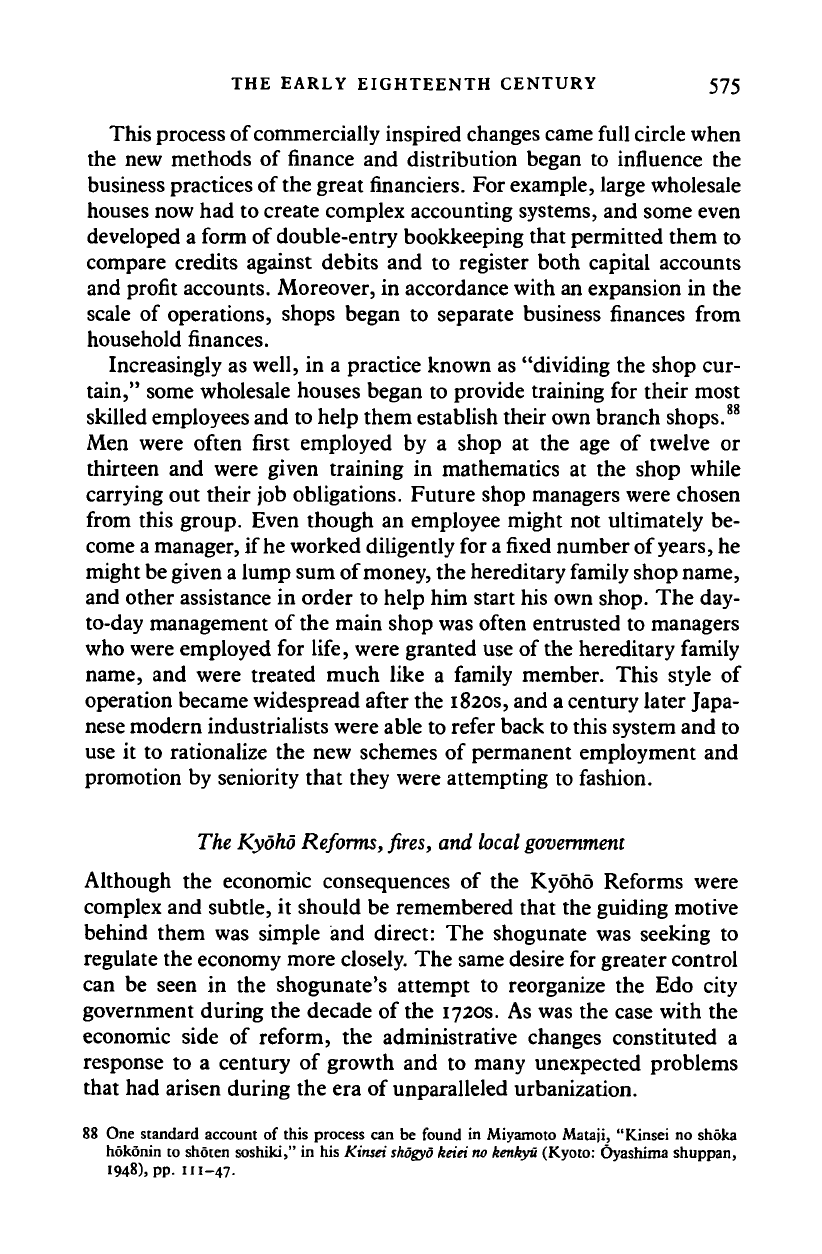
THE EARLY EIGHTEENTH CENTURY 575
This process of commercially inspired changes came full circle when
the new methods of finance and distribution began to influence the
business practices of
the
great financiers. For example, large wholesale
houses now had to create complex accounting systems, and some even
developed a form of double-entry bookkeeping that permitted them to
compare credits against debits and to register both capital accounts
and profit accounts. Moreover, in accordance with an expansion in the
scale of operations, shops began to separate business finances from
household finances.
Increasingly as well, in a practice known as "dividing the shop cur-
tain," some wholesale houses began to provide training for their most
skilled employees and to help them establish their own branch shops.
88
Men were often first employed by a shop at the age of twelve or
thirteen and were given training in mathematics at the shop while
carrying out their job obligations. Future shop managers were chosen
from this group. Even though an employee might not ultimately be-
come
a
manager, if he worked diligently for
a
fixed
number of
years,
he
might be given
a
lump sum of money, the hereditary family shop name,
and other assistance in order to help him start his own shop. The day-
to-day management of the main shop was often entrusted to managers
who were employed for life, were granted use of the hereditary family
name, and were treated much like a family member. This style of
operation became widespread after the 1820s, and a century later Japa-
nese modern industrialists were able to refer back to this system and to
use it to rationalize the new schemes of permanent employment and
promotion by seniority that they were attempting to fashion.
The Kyoho Reforms, fires, and
local government
Although the economic consequences of the Kyoho Reforms were
complex and subtle, it should be remembered that the guiding motive
behind them was simple and direct: The shogunate was seeking to
regulate the economy more closely. The same desire for greater control
can be seen in the shogunate's attempt to reorganize the Edo city
government during the decade of the 1720s. As was the case with the
economic side of reform, the administrative changes constituted a
response to a century of growth and to many unexpected problems
that had arisen during the era of unparalleled urbanization.
88 One standard account of this process can be found in Miyamoto Mataji, "Kinsei no shoka
hokonin to shoten soshiki," in his Kinsei
shogyo
keiei
no kenkyu
(Kyoto: Oyashima shuppan,
1948),
pp. 111-47.
Cambridge Histories Online © Cambridge University Press, 2008

576 COMMERCIAL CHANGE AND URBAN GROWTH
One of these unanticipated problems was fires, often poetically
referred to as "the flowers of Edo." Pestilence would be more like it,
especially for the city's commoners. The merchants and artisan wards
of Edo were densely populated, houses were constructed of wood and
paper; and firefighting equipment was rudimentary. The hand-
operated pump first came into use in Osaka only during the latter
half of the eighteenth century; but even in the nineteenth century,
this pump was used in just a few places and the most common means
of stopping fires was simply to demolish wide rows of homes in order
to create firebreaks.
Under these conditions, any fire could quickly become a major
disaster, and the documentary record reveals that the central wards of
Edo were destroyed by fire on the average of once every six years in
the 178-year period between the middle of the seventeenth century
and the 1830s.
89
In particular, exceptionally large numbers of fires
occurred in the decades of the 1650s, 1710s, I77os,and 1830s, and all
of them contributed to the social unrest of those decades.
90
Among these four periods, the largest number of fires broke out
during the decade of the 1710s. Then in the 1720s, the shogunate
changed its urban policy by forming a firefighting association and
offering rewards to those
who
could identify arsonists. The transforma-
tion in urban policy also involved a reorganization of the city.
91
In
order to prevent the spread of fires, the shogunate increased the num-
ber of public squares
(hiroba)
and issued an ordinance instructing
people to use adobe or mud plaster in home construction and to tile
their roofs, which previously had been made of wood or thatch. Al-
though this decree was not uniformly observed in every ward, espe-
cially those whose residents had sunk into serious economic straits, the
government did try to enforce it more strictly in certain designated
wards, mainly those that had been rebuilt following a fire. In time, the
practice of using the new building materials spread, and by the nine-
teenth century, streets with rows of houses constructed of adobe or
plaster and roofed with tiles gradually started to appear in cities in all
parts of Japan.
The government also began to organize firefighting brigades in al-
most all sections of
Edo.
Officials actually used red ink to divide
a
map
89 A useful introductory study to fires and fire fighting is Minami Kazuo, "Shobo," in Toyoda,
Harada, and Yamori, eds., Koza: Nihon
no hoken
toshi, vol. 2, pp. 457-71.
90 Harada Tomohiko, Kinsei wshi
sojoshi
(Kyoto: Shibunkaku shuppan, 1982), pp. 92-123.
91 Yoshioka Yuriko, "Kyoho-ki Edo machikata ni okeru sogan undo no jittai," in Chihoshi
kenkyukai kyogikai, ed.,
Toshi no
chihoshi,
pp. 108-58.
Cambridge Histories Online © Cambridge University Press, 2008
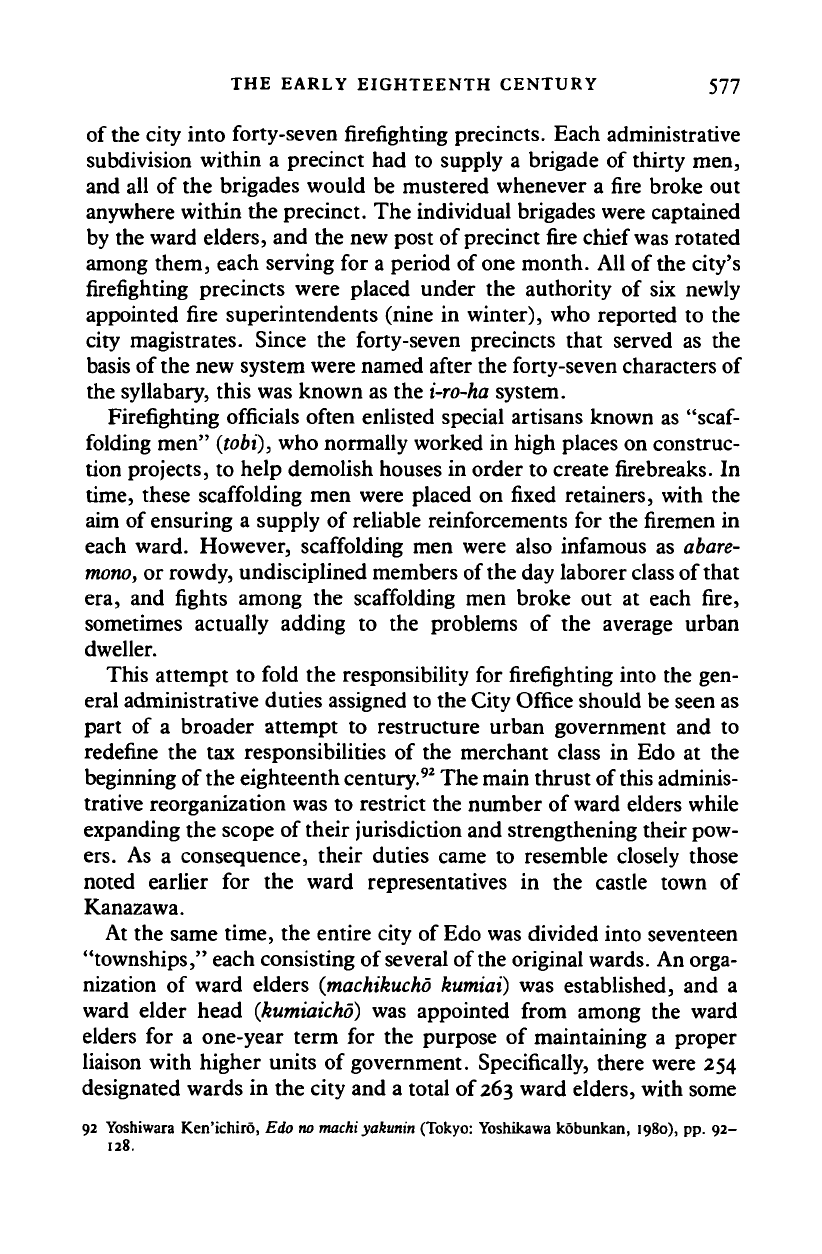
THE EARLY EIGHTEENTH CENTURY 577
of the city into forty-seven firefighting precincts. Each administrative
subdivision within a precinct had to supply a brigade of thirty men,
and all of the brigades would be mustered whenever a fire broke out
anywhere within the precinct. The individual brigades were captained
by the ward elders, and the new post of precinct fire chief
was
rotated
among them, each serving for a period of one month. All of the city's
firefighting precincts were placed under the authority of six newly
appointed fire superintendents (nine in winter), who reported to the
city magistrates. Since the forty-seven precincts that served as the
basis of the new system were named after the forty-seven characters of
the syllabary, this was known as the
i-ro-ha
system.
Firefighting officials often enlisted special artisans known as
"scaf-
folding men"
(tobi),
who normally worked in high places on construc-
tion projects, to help demolish houses in order to create firebreaks. In
time,
these scaffolding men were placed on fixed retainers, with the
aim of ensuring a supply of reliable reinforcements for the firemen in
each ward. However, scaffolding men were also infamous as
abare-
mono,
or rowdy, undisciplined members of the day laborer class of that
era, and fights among the scaffolding men broke out at each fire,
sometimes actually adding to the problems of the average urban
dweller.
This attempt to fold the responsibility for firefighting into the gen-
eral administrative duties assigned to the City Office should be seen as
part of a broader attempt to restructure urban government and to
redefine the tax responsibilities of the merchant class in Edo at the
beginning of the eighteenth century.
92
The main thrust of this adminis-
trative reorganization was to restrict the number of ward elders while
expanding the scope of their jurisdiction and strengthening their pow-
ers.
As a consequence, their duties came to resemble closely those
noted earlier for the ward representatives in the castle town of
Kanazawa.
At the same time, the entire city of Edo was divided into seventeen
"townships," each consisting of several of the original wards. An orga-
nization of ward elders
(machikucho
kumiai) was established, and a
ward elder head
(kumiaicho)
was appointed from among the ward
elders for a one-year term for the purpose of maintaining a proper
liaison with higher units of government. Specifically, there were 254
designated wards in the city and a total of
263
ward elders, with some
92 Yoshiwara Ken'ichiro, Edo no machi yakunin (Tokyo: Yoshikawa kobunkan, 1980), pp. 92-
128.
Cambridge Histories Online © Cambridge University Press, 2008
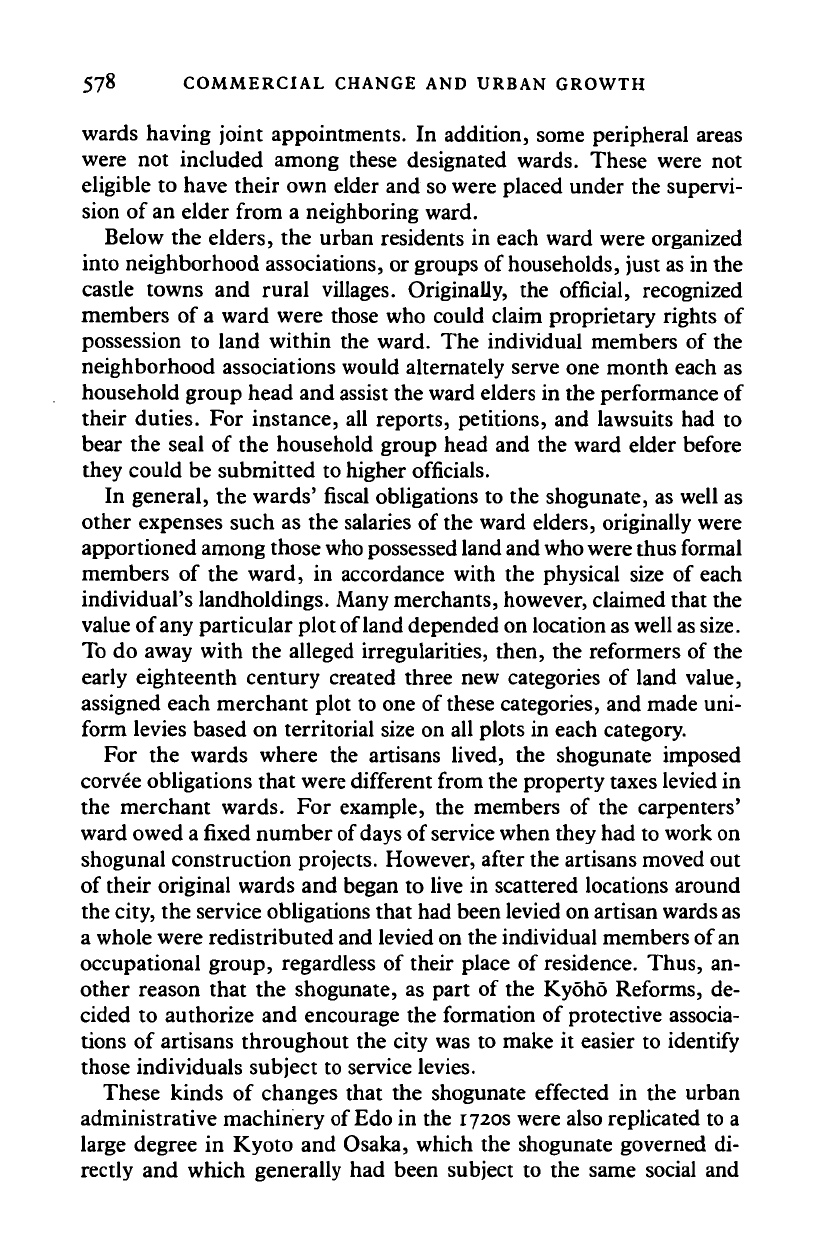
578 COMMERCIAL CHANGE AND URBAN GROWTH
wards having joint appointments. In addition, some peripheral areas
were not included among these designated wards. These were not
eligible to have their own elder and so were placed under the supervi-
sion of an elder from a neighboring ward.
Below the elders, the urban residents in each ward were organized
into neighborhood associations, or groups of households, just as in the
castle towns and rural villages. Originally, the official, recognized
members of a ward were those who could claim proprietary rights of
possession to land within the ward. The individual members of the
neighborhood associations would alternately serve one month each as
household group head and assist the ward elders in the performance of
their duties. For instance, all reports, petitions, and lawsuits had to
bear the seal of the household group head and the ward elder before
they could be submitted to higher officials.
In general, the wards' fiscal obligations to the shogunate, as well as
other expenses such as the salaries of the ward elders, originally were
apportioned among those
who
possessed land and
who were
thus formal
members of the ward, in accordance with the physical size of each
individual's landholdings. Many merchants, however, claimed that the
value of any particular plot of land depended on location as well as size.
To do away with the alleged irregularities, then, the reformers of the
early eighteenth century created three new categories of land value,
assigned each merchant plot to one of these categories, and made uni-
form levies based on territorial size on all plots in each category.
For the wards where the artisans lived, the shogunate imposed
corvee obligations that were different from the property taxes levied in
the merchant wards. For example, the members of the carpenters'
ward owed a fixed number of days of service when they had to work on
shogunal construction projects. However, after the artisans moved out
of their original wards and began to live in scattered locations around
the city, the service obligations that had been levied on artisan wards as
a whole were redistributed and levied on the individual members of an
occupational group, regardless of their place of residence. Thus, an-
other reason that the shogunate, as part of the Kyoho Reforms, de-
cided to authorize and encourage the formation of protective associa-
tions of artisans throughout the city was to make it easier to identify
those individuals subject to service levies.
These kinds of changes that the shogunate effected in the urban
administrative machinery of Edo in the 1720s were also replicated to a
large degree in Kyoto and Osaka, which the shogunate governed di-
rectly and which generally had been subject to the same social and
Cambridge Histories Online © Cambridge University Press, 2008
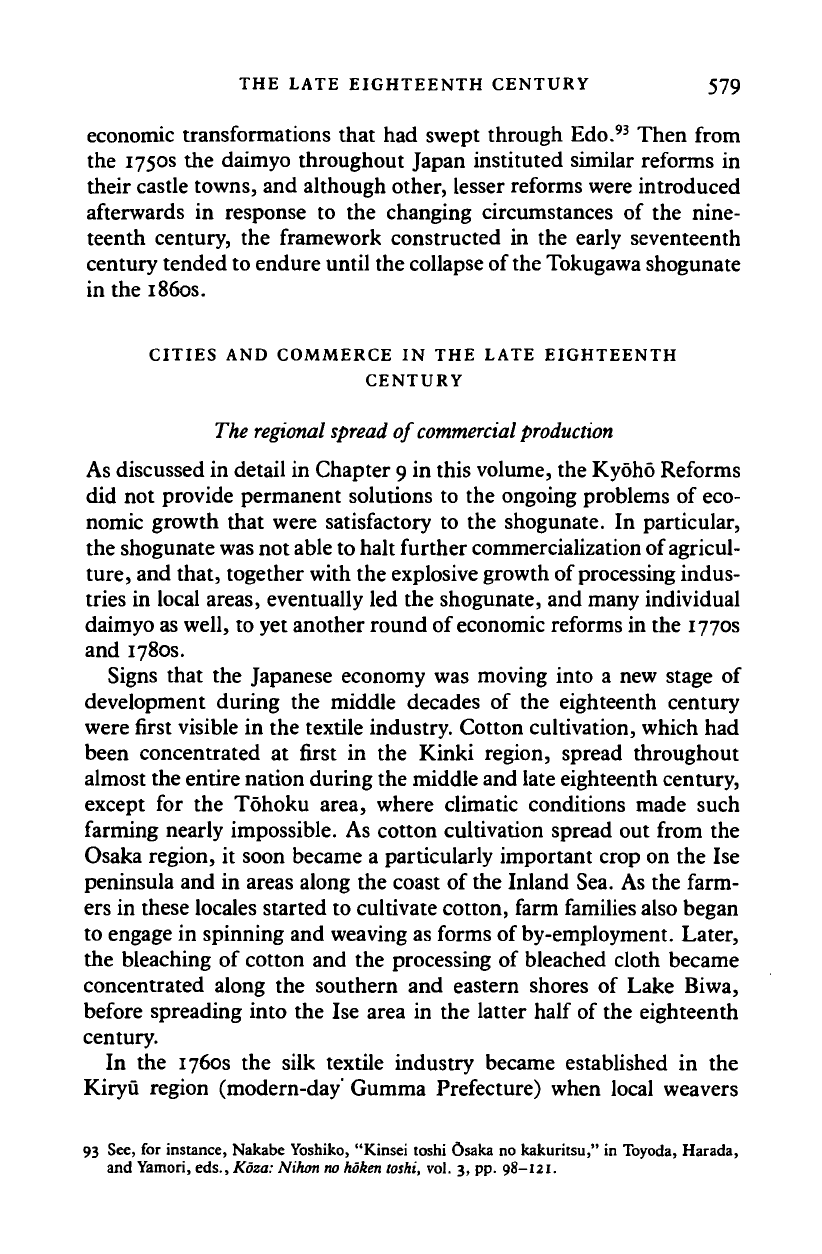
THE LATE EIGHTEENTH CENTURY 579
economic transformations that had swept through Edo.
93
Then from
the 1750s the daimyo throughout Japan instituted similar reforms in
their castle towns, and although other, lesser reforms were introduced
afterwards in response to the changing circumstances of the nine-
teenth century, the framework constructed in the early seventeenth
century tended to endure until the collapse of the Tokugawa shogunate
in the 1860s.
CITIES AND COMMERCE IN THE LATE EIGHTEENTH
CENTURY
The regional spread of commercial production
As discussed in detail in Chapter 9 in this volume, the Kyoho Reforms
did not provide permanent solutions to the ongoing problems of eco-
nomic growth that were satisfactory to the shogunate. In particular,
the shogunate
was
not able to halt further commercialization of agricul-
ture,
and that, together with the explosive growth of processing indus-
tries in local areas, eventually led the shogunate, and many individual
daimyo as well, to yet another round of economic reforms in the 1770s
and 1780s.
Signs that the Japanese economy was moving into a new stage of
development during the middle decades of the eighteenth century
were first visible in the textile industry. Cotton cultivation, which had
been concentrated at first in the Kinki region, spread throughout
almost the entire nation during the middle and late eighteenth century,
except for the Tohoku area, where climatic conditions made such
farming nearly impossible. As cotton cultivation spread out from the
Osaka region, it soon became a particularly important crop on the Ise
peninsula and in areas along the coast of the Inland Sea. As the farm-
ers in these locales started to cultivate cotton, farm families also began
to engage in spinning and weaving as forms of by-employment. Later,
the bleaching of cotton and the processing of bleached cloth became
concentrated along the southern and eastern shores of Lake Biwa,
before spreading into the Ise area in the latter half of the eighteenth
century.
In the 1760s the silk textile industry became established in the
Kiryu region (modern-day' Gumma Prefecture) when local weavers
93 See, for instance, Nakabe Yoshiko, "Kinsei toshi Osaka no kakuritsu," in Toyoda, Harada,
and Yamori, eds., Koza: Nihon no hoken toshi, vol. 3, pp.
98-121.
Cambridge Histories Online © Cambridge University Press, 2008

580 COMMERCIAL CHANGE
AND
URBAN GROWTH
mastered some
of the
dyeing techniques
for
silk that previously
had
been
an
exclusive possession
of
craftsmen
in the
Nishijin section
of
Kyoto.
As
Kiryu silk became known
for its
fine quality
and as
sales
increased, other farmers and merchants
in
the area started to engage
in
silkworm cultivation, silk thread manufacture,
and
the production of a
variety
of
silk textiles. About
the
same time, farmers
in the
mountain-
ous areas
of the
southern Kanto region started
to
produce
raw
silk
thread
and
cotton cloth
for
use
by
the great mass of urban commoners.
As this happened, towns like Hachioji
and Ome
became important
collection
and
transshipment points.
A
similar story could
be
told
for
Hokuriku, when
the
area around
the
city of Toyama became a thriving
center
for the
production of silk
and
cotton textiles.
94
This localization
of production
and the
development
of
new networks
of
exchange
dur-
ing
the
last half
of the
eighteenth century meant that Kyoto's impor-
tance
as the
center
of
the silk trade diminished greatly.
There were similar changes
in the
production
of
lamp
oil,
another
important product. Originally,
a
variety
of
fish
and
vegetables were
refined into
oil in
Kobe
and
Nishinomiya, where waterpower
was
abundant. Later, refining spread into
a
great number
of
local areas
that grew rapeseed, which producers, until that time,
had
exported
in
its
raw
state although they also processed small amounts
for
individual
use.
Not
surprisingly,
the
emergence
of
competitive marketing
sys-
tems
for
cotton, silk,
and
rapeseed generated some sharp tensions
between
the
established merchants
of
Osaka
and the
local upstarts.
Some sense
of
this
can be
felt
in the
organization
of
a
new
protective
association
of
lamp-oil traders
in
Osaka
in
1759, whose members then
pressured
the
shogunate to decree that
all
oil seeds, including rape
and
cotton seed,
be
sent
to
Osaka
for
processing.
95
It
is
also important
to
note that
the
regional growth
of
processing
industries often stimulated
the
production
of raw
materials
in
local
areas.
For
example,
in the
early seventeenth century, people
in Edo
relied
on
imports
of
soy sauce from areas
in the
Kinki region such
as
Yuasa (present-day Wakayama Prefecture) and Tatsuno (Hyogo Prefec-
ture).
Then,
by
mid-century,
the
sardine fishermen discussed earlier
took with them from Yuasa
to
Choshi
the
manufacturing techniques
employed
by the soy
sauce brewers
of
western Japan. From there,
the
brewing process became generally known among producers
in
such
localities
as
Sawara
and
Noda (Chiba Prefecture)
and
Tsuchiura
94 See Mizushima Shigeru, "Etchu orimono no hattatsu,"
Toyama shidan
34 (1966):
35-51.
95 For further details, see Nakai,
Tenkan-ki bakuhansei
no kenkyu, pp.
118-23.
Cambridge Histories Online © Cambridge University Press, 2008

THE LATE EIGHTEENTH CENTURY 581
(Ibaraki Prefecture), and merchants in those areas started to brew soy
sauce to suit the tastes of the residents of Edo, fond of
a
saltier, more
intensely flavored seasoning than was marketed in Osaka. Soon, soy
sauce manufactured in the urban centers of the Kansai region was
driven from the markets of
Edo.
Thus in a variety of products ranging
from soy sauce and cooking oil to silk and cotton cloth, rural produc-
ers were challenging the previously predominant position of the older,
more established shops of Kyoto and Osaka, many of whom had
enjoyed some form of favored government protection.
Commercial growth and new
economic
policies
Tanuma
Okitsugu.
The 1760s and 1770s witnessed the initiation of new
economic policies by the leaders of the shogunate and individual do-
mains. Often historians have focused less on this set of events than on
the subsequent Kansei Reforms; yet the policies of the 1760s and
1770s had a significant impact on the structure of economic activity in
Japan, and they deserve our close attention. To some extent, the new
policies constituted a response to the problems brought on by the
regional spread of commercial activity and the growth of
local
market-
ing systems. As we shall see, the aggressive behavior of rural-based
merchants and the decline of the central role of Osaka merchants
caused dislocations and difficulties that would force their attention on
government officials when the established but threatened merchants
appealed for protection.
The new policies also addressed some older, and frustratingly persis-
tent, fiscal problems that had plagued the shogunate and daimyo gov-
ernments. The central concern here was to find some way to eliminate
what had by now become chronic budgetary shortfalls and to reduce
reliance on loans from merchant houses. Moreover, government offi-
cials hoped to acquire some control over prices, in order to overcome
the inflation that had reappeared after the economic recession of the
late Kyoho period and that was seen as being responsible for both
driving up government expenditures and causing serious financial
problems for the samurai status group.
96
The contemporaries who struggled with
these
problems and the
histo-
rians
who have
reviewed their policy decisions
have
not had an easy time
understanding the causal relationships between persistent budgetary
96 An early and still useful study of domain indebtedness is Sekiyama Naotaro, Nihon kahei
kin'yushi kenkyu
(Tokyo: Shinkeizaishi, 1943).
Cambridge Histories Online © Cambridge University Press, 2008
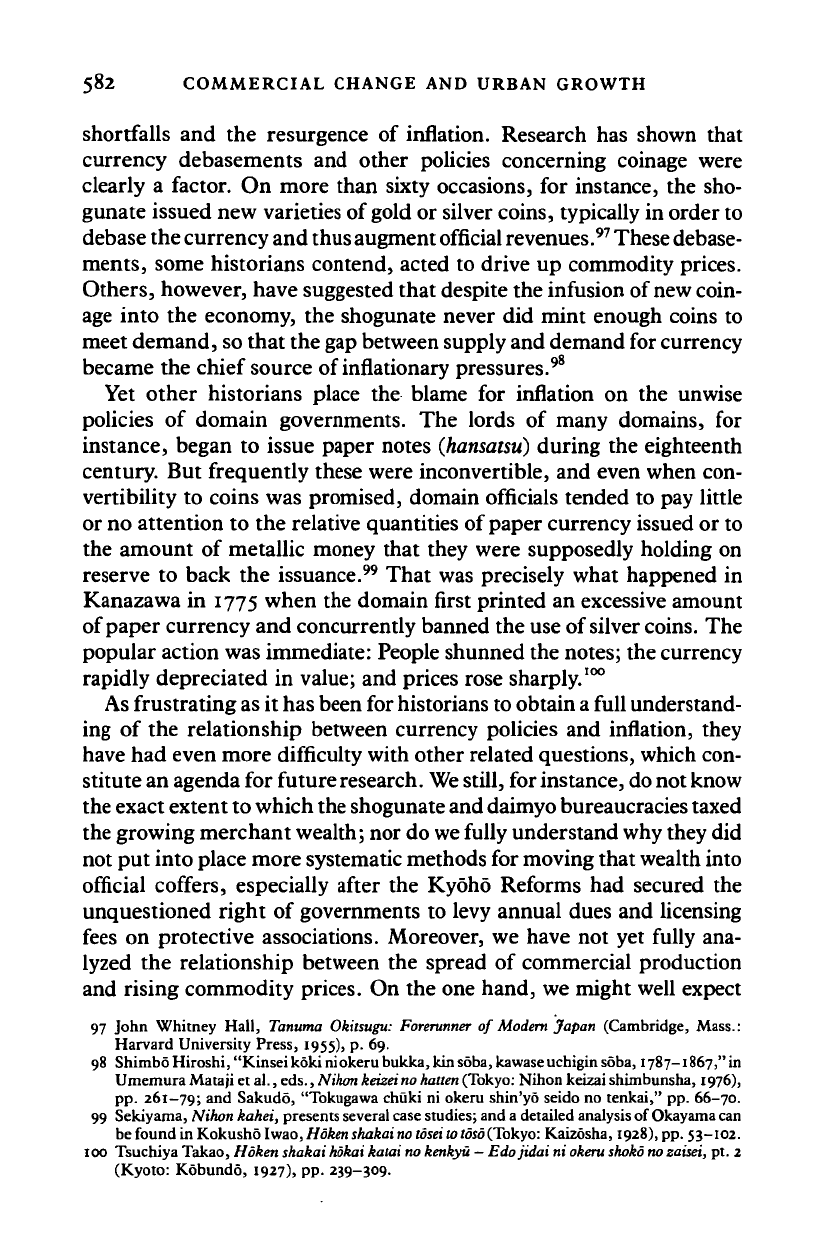
582 COMMERCIAL CHANGE AND URBAN GROWTH
shortfalls and the resurgence of inflation. Research has shown that
currency debasements and other policies concerning coinage were
clearly a factor. On more than sixty occasions, for instance, the sho-
gunate issued new varieties of gold or silver coins, typically in order to
debase the currency and thus augment official revenues.
97
These debase-
ments, some historians contend, acted to drive up commodity prices.
Others, however, have suggested that despite the infusion of new coin-
age into the economy, the shogunate never did mint enough coins to
meet demand, so that the
gap
between supply and demand for currency
became the chief source of inflationary pressures.
98
Yet other historians place the blame for inflation on the unwise
policies of domain governments. The lords of many domains, for
instance, began to issue paper notes
(hansatsu)
during the eighteenth
century. But frequently these were inconvertible, and even when con-
vertibility to coins was promised, domain officials tended to pay little
or no attention to the relative quantities of paper currency issued or to
the amount of metallic money that they were supposedly holding on
reserve to back the issuance.
99
That was precisely what happened in
Kanazawa in 1775 when the domain first printed an excessive amount
of paper currency and concurrently banned the use of silver
coins.
The
popular action was immediate: People shunned the notes; the currency
rapidly depreciated in value; and prices rose sharply.
100
As
frustrating
as
it has been for historians
to
obtain
a
full understand-
ing of the relationship between currency policies and inflation, they
have had even more difficulty with other related questions, which con-
stitute an agenda for future
research.
We
still, for instance,
do
not know
the exact extent to which the shogunate and daimyo bureaucracies taxed
the growing merchant
wealth;
nor do
we
fully understand why they did
not put into place more systematic methods for moving that wealth into
official coffers, especially after the Kyoho Reforms had secured the
unquestioned right of governments to levy annual dues and licensing
fees on protective associations. Moreover, we have not yet fully ana-
lyzed the relationship between the spread of commercial production
and rising commodity prices. On the one hand, we might well expect
97 John Whitney Hall, Tanuma Okilsugu: Forerunner of Modem Japan (Cambridge, Mass.:
Harvard University Press, 1955), p. 69.
98 Shimbo Hiroshi, "Kinsei koki
ni
okeru bukka, kin soba, kawase uchigin soba, 1787-1867," in
Umemura Mataji et al., eds., Nihon keizei
no
hauen (Tokyo: Nihon keizai shimbunsha, 1976),
pp.
261-79; and Sakudo, "Tokugawa chuki ni okeru shin'yo seido no tenkai," pp. 66-70.
99 Sekiyama, Nihon kahei, presents several case studies; and a detailed analysis of Okayama can
be found in Kokusho Iwao, Hoken shakai
no tosei to toso
(Tokyo:
Kaizosha, 1928), pp. 53-102.
100 Tsuchiya Takao, Hoken shakai hokai katai no kenkyu - Edojidai ni
okeru shokd no
zaisei, pt. 2
(Kyoto: Kobundo, 1927), pp. 239-309.
Cambridge Histories Online © Cambridge University Press, 2008
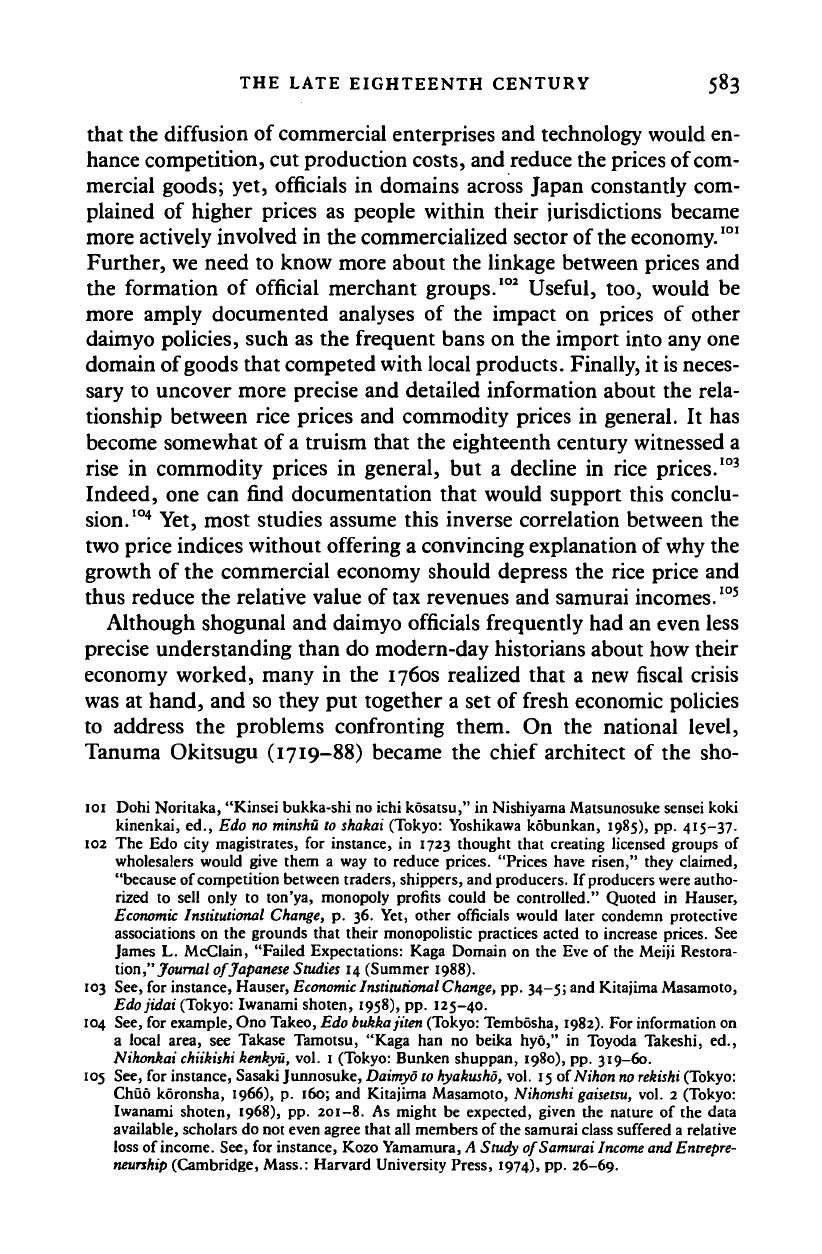
THE LATE EIGHTEENTH CENTURY 583
that the diffusion of commercial enterprises and technology would en-
hance competition, cut production costs, and reduce the prices of com-
mercial goods; yet, officials in domains across Japan constantly com-
plained of higher prices as people within their jurisdictions became
more actively involved in the commercialized sector of
the
economy.
101
Further, we need to know more about the linkage between prices and
the formation of official merchant groups.
102
Useful, too, would be
more amply documented analyses of the impact on prices of other
daimyo policies, such as the frequent bans on the import into any one
domain of goods that competed with local products. Finally, it is neces-
sary to uncover more precise and detailed information about the rela-
tionship between rice prices and commodity prices in general. It has
become somewhat of
a
truism that the eighteenth century witnessed a
rise in commodity prices in general, but a decline in rice prices.
103
Indeed, one can find documentation that would support this conclu-
sion.
104
Yet, most studies assume this inverse correlation between the
two price indices without offering a convincing explanation of why the
growth of the commercial economy should depress the rice price and
thus reduce the relative value of tax revenues and samurai incomes.
105
Although shogunal and daimyo officials frequently had an even less
precise understanding than do modern-day historians about how their
economy worked, many in the 1760s realized that a new fiscal crisis
was at hand, and so they put together a set of fresh economic policies
to address the problems confronting them. On the national level,
Tanuma Okitsugu (1719-88) became the chief architect of the sho-
101 Dohi Noritaka, "Kinsei bukka-shi no ichi kosatsu," in Nishiyama Matsunosuke sensei koki
kinenkai, ed., Edo no
minshu
to shakai (Tokyo: Yoshikawa kobunkan, 1985), pp. 415-37.
102 The Edo city magistrates, for instance, in 1723 thought that creating licensed groups of
wholesalers would give them a way to reduce prices. "Prices have risen," they claimed,
"because of competition between traders, shippers, and producers. If producers were autho-
rized to sell only to ton'ya, monopoly profits could be controlled." Quoted in Hauser,
Economic Institutional Change, p. 36. Yet, other officials would later condemn protective
associations on the grounds that their monopolistic practices acted to increase prices. See
James L. McClain, "Failed Expectations: Kaga Domain on the Eve of the Meiji Restora-
tion,"
Journal of Japanese Studies 14 (Summer 1988).
103 See, for instance, Hauser,
Economic Institutional
Change,
pp. 34-5; and Kitajima Masamoto,
Edojidai (Tokyo: Iwanami shoten, 1958), pp. 125-40.
104 See, for example, Ono Takeo, Edo bukkajiien (Tokyo: Tembosha, 1982). For information on
a local area, see Takase Tamotsu, "Kaga han no beika hyo," in Toyoda Takeshi, ed.,
Nihonkai
chiikishi
kenkyu, vol. 1 (Tokyo: Bunken shuppan, 1980), pp. 319-60.
105 See, for instance, Sasaki Junnosuke, Daimyo to
hyakusho,
vol. 15 oiNihon
no rekishi
(Tokyo:
Chuo koronsha, 1966), p. 160; and Kitajima Masamoto, Nihonshi
gaisetsu,
vol. 2 (Tokyo:
Iwanami shoten, 1968), pp. 201-8. As might be expected, given the nature of the data
available, scholars do not even agree that all members of the samurai class suffered a relative
loss of income. See, for instance, Kozo Yamamura, A Study of Samurai
Income
and
Entrepre-
neurskip
(Cambridge, Mass.: Harvard University Press, 1974), pp. 26-69.
Cambridge Histories Online © Cambridge University Press, 2008
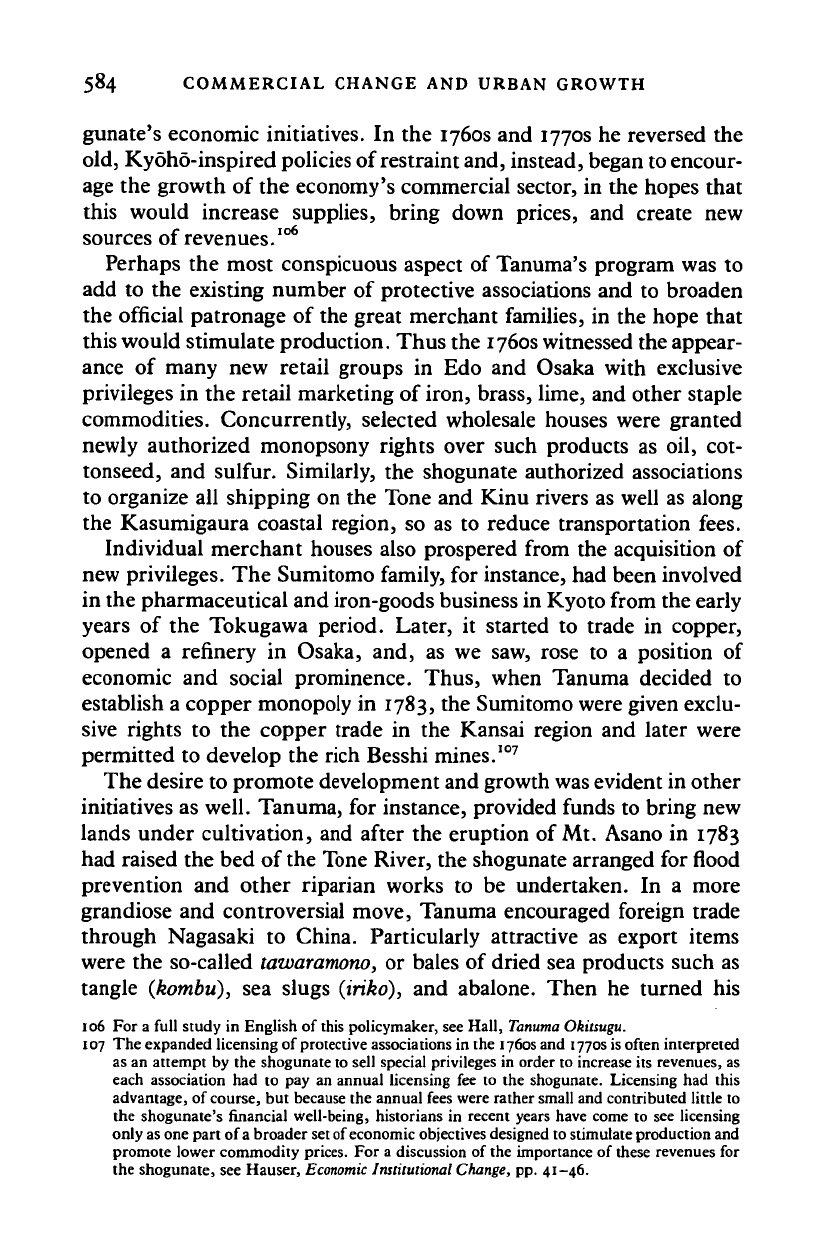
584 COMMERCIAL CHANGE
AND
URBAN GROWTH
gunate's economic initiatives.
In the
1760s
and
1770s
he
reversed
the
old, Kyoho-inspired policies of restraint and, instead, began to encour-
age
the
growth
of
the economy's commercial sector,
in the
hopes that
this would increase supplies, bring down prices,
and
create
new
sources
of
revenues.
106
Perhaps
the
most conspicuous aspect
of
Tanuma's program
was to
add
to the
existing number
of
protective associations
and to
broaden
the official patronage
of
the great merchant families,
in the
hope that
this would stimulate production. Thus
the
1760s witnessed the appear-
ance
of
many
new
retail groups
in Edo and
Osaka with exclusive
privileges
in the
retail marketing
of
iron, brass, lime,
and
other staple
commodities. Concurrently, selected wholesale houses were granted
newly authorized monopsony rights over such products
as oil, cot-
tonseed,
and
sulfur. Similarly,
the
shogunate authorized associations
to organize
all
shipping
on the
Tone
and
Kinu rivers
as
well
as
along
the Kasumigaura coastal region,
so as to
reduce transportation fees.
Individual merchant houses also prospered from
the
acquisition
of
new privileges.
The
Sumitomo family,
for
instance,
had
been involved
in
the
pharmaceutical
and
iron-goods business
in
Kyoto from the early
years
of the
Tokugawa period. Later,
it
started
to
trade
in
copper,
opened
a
refinery
in
Osaka,
and, as we saw,
rose
to a
position
of
economic
and
social prominence. Thus, when Tanuma decided
to
establish
a
copper monopoly
in
1783,
the
Sumitomo were given exclu-
sive rights
to the
copper trade
in the
Kansai region
and
later were
permitted
to
develop
the
rich Besshi mines.
107
The desire
to
promote development and growth was evident
in
other
initiatives
as
well. Tanuma,
for
instance, provided funds
to
bring
new
lands under cultivation,
and
after
the
eruption
of
Mt. Asano
in 1783
had raised
the bed of
the Tone River,
the
shogunate arranged
for
flood
prevention
and
other riparian works
to be
undertaken.
In a
more
grandiose
and
controversial move, Tanuma encouraged foreign trade
through Nagasaki
to
China. Particularly attractive
as
export items
were
the
so-called
tawaramono,
or
bales
of
dried
sea
products such
as
tangle (kombu),
sea
slugs (iriko),
and
abalone. Then
he
turned
his
106 For a full study in English of this policymaker, see Hall,
Tanuma
Okitsugu.
107 The expanded licensing of protective associations in the 1760s and 1770s is often interpreted
as an attempt by the shogunate to sell special privileges in order to increase its revenues, as
each association had to pay an annual licensing fee to the shogunate. Licensing had this
advantage, of course, but because the annual fees were rather small and contributed little to
the shogunate's financial well-being, historians in recent years have come to see licensing
only as one part of
a
broader set of economic objectives designed to stimulate production and
promote lower commodity prices. For a discussion of the importance of these revenues for
the shogunate, see Hauser,
Economic
Institutional
Change,
pp. 41-46.
Cambridge Histories Online © Cambridge University Press, 2008
